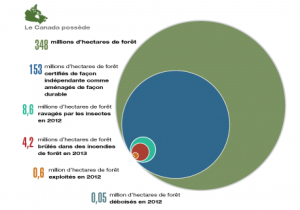
The latest report on the state of Canada’s forests by the federal government department that’s charged with monitoring it (Natural Resources Canada) has a graphic that succinctly explains much of what PPEC has been writing about during the course of the year.
The Deforestation Myth: Most of the deforestation occurring in the world is happening in tropical forests, not in Canada or even North America. The percentage of land lost to deforestation in Canada in the latest data year amounts to less than 0.02% of the country’s 348 million hectares of forest. And contrary to popular opinion, the major cause of that net deforestation in Canada is not the forestry industry but rather forest lost to agriculture and oil and gas exploration. Canada’s net deforestation is represented by the smallest circle in the graphic. You have to squint to see it.

The “Running out of Trees” mantra: The Canadian lumber and forest industry harvested less than 0.6 million hectares in 2012 (which is actually down by 12% on the previous year). That 0.6 million hectares represents less than 0.2% of Canada’s forest lands (as depicted in the second smallest circle). By law, that harvest must be regenerated, either naturally or by direct seeding and planting. Over a thousand new forest seedlings on average are planted somewhere in Canada every minute.
Natural disturbances have a far greater impact on Canada’s forests than human disturbances: Some 4.2 million hectares of forest was lost to forest fires (the red circle) in the latest data year, more than seven times the size of the commercial harvest. Even larger was the loss of forests to insects (mainly the mountain pine beetle), more than 14 times the area harvested (the turquoise circle).
Canada leads the world in independent, third-party certification of sustainably managed forests: Over 40% of the world’s certified forests are right here in Canada where they are certified to one or more of the internationally recognised certification programs: Forest Stewardship Council (FSC), Sustainable Forestry Initiative (SFI) or Programme for the Endorsement of Forestry Certification (PEFC) which partners with the Canadian Standards Association (CSA). This is the blue circle. More impressive perhaps is the fact that the area independently certified as sustainably managed forest is an incredible 255 times larger than the total area actually harvested. Now there’s a model for the oil and gas industry to follow!
If you want to get the facts on the state of Canada’s forests, in a very readable and concise format (43 illustrated pages before you hit the back-up data and sources), checking out this Natural Resources Canada report would be a great start.
